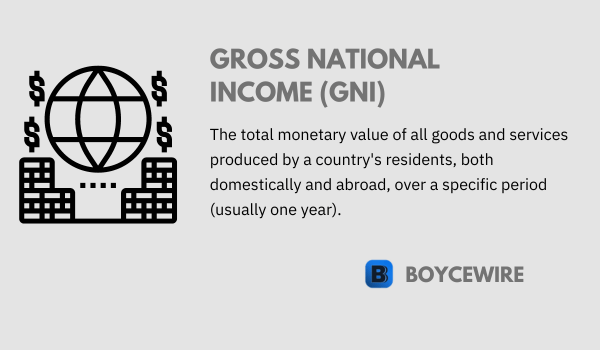Table of Contents ![]()
Gross National Income (GNI): Definition, How to Calculate & Criticisms

What is GNI?
Gross National Income (GNI) is an economic measure that represents the total monetary value of all goods and services produced by a country’s residents, both domestically and abroad, over a specific period (usually one year). It includes the Gross Domestic Product (GDP) and adds income earned by residents from overseas investments, while subtracting income earned by non-residents within the country. In other words, it measures the total income generated by a country’s citizens, regardless of whether they reside in the country or not.
GNI is often used to compare the economic performance of different countries, track economic growth over time, and assess the overall standard of living. It can also be adjusted for purchasing power parity (PPP) to account for differences in the cost of living across countries.
Key Points
- Central banks, like the Federal Reserve in the US or the European Central Bank in the Eurozone, are the institutions responsible for implementing monetary policy.
- Central banks have various tools at their disposal to manage the money supply and influence interest rates, including open market operations, setting reserve requirements, and adjusting the discount rate.
- Central banks buy and sell government bonds in the open market to increase or decrease the money supply. Buying bonds injects money into the economy, while selling bonds reduces the money supply.
- Central banks may require commercial banks to hold a certain percentage of their deposits as reserves, which can impact the amount of money available for lending and thus influence the money supply.
How to Calculate GNI
To calculate Gross National Income (GNI), you need to follow these steps:
- Calculate Gross Domestic Product (GDP): GDP is the monetary value of all goods and services produced within a country’s borders in a specific period, usually a year. There are three main approaches to calculating GDP: the production approach, the income approach, and the expenditure approach. You can choose any of these methods to calculate GDP.
- Add net factor income from abroad: Net factor income from abroad is the difference between the income earned by a country’s residents from overseas investments and the income earned by non-residents within the country. This includes wages, salaries, profits, rents, and interest received from abroad, minus the same types of income paid to non-residents.
- Adjust for statistical discrepancies, if necessary: Sometimes, there may be discrepancies in the data due to differences in the methods used to estimate various components of GNI. In such cases, adjustments are made to ensure that the GNI is accurate and consistent.
So, the formula for GNI is:
GNI = GDP + Net Factor Income from Abroad
In summary, to calculate GNI, you first need to calculate the GDP of a country and then add the net factor income from abroad. This will give you the total income generated by a country’s residents, regardless of whether they reside in the country or not.
Gross National Income Example
Let’s consider a hypothetical example to illustrate the calculation of Gross National Income (GNI):
Country A has the following economic data for the year:
- Gross Domestic Product (GDP): $1,000 billion
- Income earned by Country A’s residents from overseas investments: $50 billion
- Income earned by non-residents within Country A: $30 billion
- Using the GNI formula, we can calculate Country A’s GNI as follows:
- GNI = GDP + (Income earned by residents from overseas investments – Income earned by non-residents within the country)
- GNI = $1,000 billion + ($50 billion – $30 billion)
- GNI = $1,000 billion + $20 billion
- GNI = $1,020 billion
So, Country A’s Gross National Income (GNI) for the year is $1,020 billion. This represents the total monetary value of all goods and services produced by Country A’s residents, both domestically and abroad, during that year.
Criticisms of GNI
While Gross National Income (GNI) is a widely used measure of a country’s economic performance and standard of living, it has some limitations and has been subject to various criticisms:
1. Inequality
GNI does not account for income distribution within a country. A high GNI may not accurately reflect the living standards of the majority of the population if there is significant income inequality.
2. Non-market activities
GNI does not include non-market activities such as unpaid domestic work, volunteer work, and subsistence farming, which may contribute to a country’s well-being but are not included in the monetary transactions.
3. Quality of life
GNI focuses solely on economic output and does not directly measure aspects such as education, healthcare, and environmental quality, which are crucial to the overall well-being of a country’s citizens.
4. Informal economy
GNI may not accurately capture the size of a country’s informal economy, which includes unreported and untaxed economic activities. This can lead to an underestimation of a country’s actual economic performance.
5. Environmental costs
GNI does not account for environmental degradation or the depletion of natural resources resulting from economic activities, which can have long-term negative impacts on a country’s sustainable development.
6. Currency fluctuations
Comparisons between countries can be affected by currency fluctuations when GNI is expressed in a common currency, such as the US dollar. This can lead to misleading conclusions about relative economic performance.
7. Purchasing power differences
GNI does not inherently account for differences in purchasing power across countries. To address this, GNI can be adjusted for purchasing power parity (PPP), which takes into account the relative cost of living and inflation rates.
Despite these limitations, GNI remains an important tool for comparing economic performance across countries and tracking economic growth over time. However, it is essential to consider other indicators, such as the Human Development Index (HDI) and the Genuine Progress Indicator (GPI), to obtain a more comprehensive understanding of a country’s overall well-being and development.
GNI vs GNP
Gross National Income (GNI) and Gross National Product (GNP) are both measures of a country’s economic performance. They are closely related and sometimes used interchangeably, but there are some subtle differences between the two.
Gross National Income (GNI)
GNI is the total monetary value of all goods and services produced by a country’s residents, both domestically and abroad, over a specific period (usually one year). It includes the Gross Domestic Product (GDP) and adds income earned by residents from overseas investments, while subtracting income earned by non-residents within the country.
Formula: GNI = GDP + Net Factor Income from Abroad
Gross National Product (GNP)
GNP is the total market value of all goods and services produced by a country’s residents, both domestically and abroad, over a specific period (usually one year). It includes GDP and adds the net income residents receive from abroad, which includes net factor income and net transfers.
Formula: GNP = GDP + Net Income from Abroad
The difference between GNI and GNP lies mainly in the treatment of net income from abroad:
- GNI focuses on net factor income from abroad, which includes wages, salaries, profits, rents, and interest earned by residents from overseas investments, minus the same types of income paid to non-residents.
- GNP includes net income from abroad, which covers not only net factor income but also net transfers, such as foreign aid and remittances.
In most cases, GNI and GNP values are quite similar, as net transfers are generally a small component of a country’s national income. However, for countries with significant net transfers, there might be a noticeable difference between GNI and GNP. Overall, both indicators are used to measure a country’s economic performance, and the choice between them often depends on the specific context or the preferences of the organization or researcher analyzing the data.
FAQs
GNI is the total monetary value of all goods and services produced by a country’s residents, both domestically and abroad, over a specific period (usually one year). It includes the Gross Domestic Product (GDP) and adds income earned by residents from overseas investments, while subtracting income earned by non-residents within the country.
GNI is calculated using the following formula:
GNI = GDP + Net Factor Income from Abroad
To calculate GNI, you first need to calculate a country’s GDP, and then add the net factor income from abroad, which is the difference between the income earned by a country’s residents from overseas investments and the income earned by non-residents within the country.
Gross Domestic Product (GDP) is the monetary value of all goods and services produced within a country’s borders in a specific period, usually a year. In contrast, GNI includes the GDP and also accounts for income earned by residents from overseas investments, minus income earned by non-residents within the country. Essentially, GNI measures the total income generated by a country’s citizens, regardless of whether they reside in the country or not.
Gross National Income (GNI) focuses on net factor income from abroad, while Gross National Product (GNP) includes net income from abroad, which covers not only net factor income but also net transfers, such as foreign aid and remittances. In most cases, GNI and GNP values are quite similar, with net transfers generally being a small component of a country’s national income.
Some limitations of GNI include:
-It does not account for income distribution or inequality within a country.
-It does not include non-market activities, such as unpaid domestic work or subsistence farming.
-It does not directly measure aspects of quality of life, such as education, healthcare, or environmental quality.
-It may not accurately capture the size of a country’s informal economy.
-It does not account for environmental degradation or depletion of natural resources.
-It can be affected by currency fluctuations when comparing different countries.
-It does not inherently account for differences in purchasing power across countries.
About Paul
Paul Boyce is an economics editor with over 10 years experience in the industry. Currently working as a consultant within the financial services sector, Paul is the CEO and chief editor of BoyceWire. He has written publications for FEE, the Mises Institute, and many others.

Further Reading
 Price Elasticity of Demand: Definition, Types & Examples - Price Elasticity of Demand (PED) measures how customers change their behaviour when prices change. In other words, it refers to…
Price Elasticity of Demand: Definition, Types & Examples - Price Elasticity of Demand (PED) measures how customers change their behaviour when prices change. In other words, it refers to…  Barriers to Entry: Definition, Examples & Types - A barrier to entry is simply an obstacle that new businesses face when entering the market. This can come in…
Barriers to Entry: Definition, Examples & Types - A barrier to entry is simply an obstacle that new businesses face when entering the market. This can come in…  How is Inflation Measured - So now we have looked at what money essentially represents, let us look at how inflation is measured. Inflation is…
How is Inflation Measured - So now we have looked at what money essentially represents, let us look at how inflation is measured. Inflation is… 